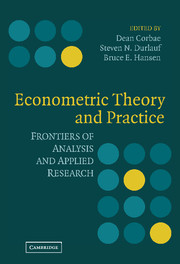Book contents
- Frontmatter
- Contents
- Preface: In Praise of a Remarkable Teacher
- Contributors
- Introduction
- PART I HIGHER-ORDER ASYMPTOTICS
- PART II IV SPECIFICATION TESTS
- PART III NONSTATIONARITY
- 6 Extracting Cycles from Nonstationary Data
- 7 Nonstationary Nonlinearity: An Outlook for New Opportunities
- 8 Multiple Structural Change Models: A Simulation Analysis
- PART IV LAD AND QUANTILE REGRESSION
- PART V NONSTATIONARY PANELS
- Index
8 - Multiple Structural Change Models: A Simulation Analysis
Published online by Cambridge University Press: 05 June 2012
- Frontmatter
- Contents
- Preface: In Praise of a Remarkable Teacher
- Contributors
- Introduction
- PART I HIGHER-ORDER ASYMPTOTICS
- PART II IV SPECIFICATION TESTS
- PART III NONSTATIONARITY
- 6 Extracting Cycles from Nonstationary Data
- 7 Nonstationary Nonlinearity: An Outlook for New Opportunities
- 8 Multiple Structural Change Models: A Simulation Analysis
- PART IV LAD AND QUANTILE REGRESSION
- PART V NONSTATIONARY PANELS
- Index
Summary
INTRODUCTION
Both the statistics and econometrics literature contain a vast amount of work on issues related to structural change, most of it specifically designed for the case of a single change. The problem of multiple structural changes, however, has received considerably less attention. Recently, Bai and Perron (1998, 2003a) provided a comprehensive treatment of various issues in the context of multiple structural change models: consistency of estimates of the break dates, tests for structural changes, confidence intervals for the break dates, methods to select the number of breaks, and efficient algorithms to compute the estimates. Their results are solely asymptotic, however, and the adequacy in finite samples remains to be investigated. This chapter is intended to fill this gap partially.
We present simulation results pertaining to the behavior of the estimators and tests in finite samples. We consider the problem of forming confidence intervals for the break dates under various hypotheses about the structure of the data and errors across segments. In particular, we may allow the data and errors to have different distributions across segments or impose a common structure. The issue of testing for structural changes is also considered under very general conditions on the data and the errors and the properties of tests – both in the data-generating processes and in the specification of the tests. We also address the issue of estimating the number of breaks.
- Type
- Chapter
- Information
- Econometric Theory and PracticeFrontiers of Analysis and Applied Research, pp. 212 - 238Publisher: Cambridge University PressPrint publication year: 2006
- 99
- Cited by



